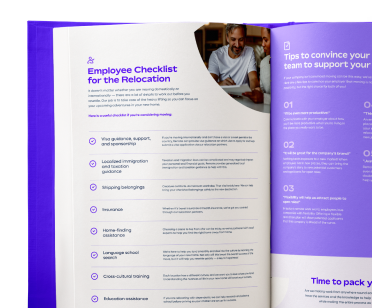
Remote & Async Work — 14 min

Visas and Work Permits — 14 min
Employers are responsible for following all relevant labor and tax laws when their employees are relocating to the Philippines. This includes obtaining the necessary work permits and visas to ensure team members can legally live and work in the country.
Even unintentional non-compliance with Philippine laws and regulations can lead to penalties and fines. Most companies work with an employer of record (EOR) to help streamline the process and avoid non-compliance risks.
The best way to minimize risk and liability while hiring in the Philippines or abroad is to understand immigration laws. This article serves as your guide for compliance with Philippines work visa requirements and work permits when you’re:
Relocating existing employees to the Philippines
Hiring non-citizens of the Philippines
Managing compliance for digital nomads working in the Philippines
Hiring candidates in the Philippines without an owned entity
Ready to learn more? Let’s dive in.
To employ non-citizens in the Philippines, the first step is to conduct a right-to-work check to make sure the employee is authorized to work in the country. Following this, you’ll have to make sure the employee has all the required paperwork — such as a valid Philippines work visa and work permit — in place for their role and the duration of their stay in the Philippines. Additionally, you'll also have to comply with all local labor, immigration, and taxation laws.
As an employer, it's your responsibility to ensure that all Philippine permissions are met before the candidate arrives in the country. Even if the employee is planning to travel for just a short period, there can still be tax and legal implications for your business.
Failure to remain compliant throughout the entire process puts your company at higher risk, which can lead to financial and legal consequences. Employees could face deportation and your company could face legal issues or criminal prosecution if they fail to comply with employment laws.
Before the pandemic, it was easier for remote employees to work in the country on a tourist visa. However, governments are becoming more strict and enforcing legislation that prohibits working in a foreign country with only a tourist visa.
When working with non-citizens in the Philippines, you'll need to ensure that they are legally allowed to start work as soon as they arrive.
The types of workers who will require a work authorization check are:
Temporary residents
Work permit residents
Permanent residents
The process of employment checks and processing work permits can be expensive, cumbersome, and time-consuming. Your company will have to a strong grasp of local labor and tax laws and have the resources to manage the relocation process.
Alternatively, you can choose to work with an EOR like Remote to simplify and streamline the relocation process. Your employees can upload documents directly to the platform, and Remote's expert Mobility team can process a right-to-work check on your behalf and facilitate the Philippines work permit process. If an employee is found to have an invalid work permit, Remote will work with all parties to fast-track the process.
Learn how to simplify your planned relocation with this walkthrough guide. We outline the key steps for you and your employer to enable a compliant, efficient, and hassle-free move.

The Philippine government requires all foreign nationals to obtain a work visa from the Bureau of Immigration if they plan to work in the country. Your employees will also need to secure an Alien Employment Permit (AEP) that has been issued by the Department of Labor and Employment (DOLE).
Obtaining a work visa lets the Philippine government know your employee is staying in the country with the intent to work. It also allows an extended period of stay compared to a tourist visa.
The work visa in the Philippines allows foreign nationals to conduct work and is issued for anywhere between one and three years. The official length will be determined by the individual's employment contract. Employees can, however, extend their visas by requesting an additional period of one to three years.
The work visa process can be lengthy, and the timeline will not always align with how quickly you need employees in the Philippines. Because of this, the country has established a provisional work permit that allows foreign nationals to start working before the visa process is complete. Once the employee files the AEP application, they will be eligible to apply for the provisional work permit and may only have to wait two weeks to be approved.
As is the case in most other countries, the work permit establishes what type of work the employee will be doing, where they will be located, and the length of employment. If any of these details change, the employee will need to request a new AEP because their old one will no longer be valid.
Completing the visa and permit process is complicated and requires intimate knowledge of local Philippine labor, tax, and immigration laws. To remain fully compliant and save time and resources, it's best to work with an EOR like Remote. Remote’s team of employment experts has the local knowledge to navigate Philippino law quickly and easily.
Because all foreign nationals in the Philippines will require both a visa and a permit to work for your company, your company should take an active interest in all aspects of the process. Work visas in the Philippines have eligibility requirements that must be met to become compliant and legal in the country.
Several types of work visas may apply to different job sectors or lengths of employment. Most employees will apply for the 9(g) work visa (more on this below) because it's the most common visa issued for foreign nationals.
Unless you're working with an EOR, your company will need to keep track of all the requirements.
Your employee must acquire a work permit before they can secure a work visa. However, some foreign nationals are exempt from needing an AEP, including:
Any foreign nationals with permanent residence under Philippine immigration law, or temporary resident visa holders
Any members of the diplomatic service and foreign government officials
Owners or representatives of companies that are accredited by the Philippines Overseas Employment Administration
There are different types of visas offered by the government, but not all of them allow you to work in the country as a foreign national.
Here's a list of visas and work permits that allow employees to work in the Philippines.
If your employee needs to make a stop in the Philippines for work but doesn't intend to stay there for several years, the temporary visitor's visa for business purposes, or the 9(a) visa, is ideal.
The 9(a) visa allows most foreign nationals to stay in the Philippines for 30 days, although the actual length of stay allowed will vary depending on the country of origin. Some people may only be allowed to stay for seven days, whereas others can stay for 59 days. Once the initial period has been completed, your employee will have the option to extend the stay for a maximum of 16 months.
The 9(g) visa is the most common type of visa awarded to foreign nationals seeking work in the Philippines. Before obtaining this visa, an employee must secure an AEP from DOLE.
The 9(g) visa allows foreign nationals multiple entries into the country, so the employee may travel outside the country while still being employed in the Philippines. The exact length of the visa will depend on the type of work outlined in the employment contract.
The entire process of applying for this visa takes around two to three months. This includes the application for the AEP, which usually takes anywhere from two to three weeks. Employees who can't wait this long to obtain a work visa and permit still have the option to apply for the provisional work permit, which takes less time to process but costs more.
The 9(D) visa is reserved for foreign nationals who are looking to work in the Philippines but belong to countries that have a bilateral trade agreement with the Philippines. The countries with this type of agreement are Japan, Germany, and the United States. Employees can use this visa for up to two years.
There are specific requirements for employees seeking the treaty trader's visa:
The employee has the intention to leave the Philippines once their employment contract is over.
The employee has the same nationality as the employer.
The employer is conducting substantial trade with the Philippines, amounting to at least $120,000.
The employee is an executive or in a supervisor position in the company.
Foreign nationals who hold a temporary visitor visa but still want to work in the country will need a provisional work permit. This permit is ideal for employees who are already undergoing the 9(g) visa application process but want to obtain legal employment status more quickly.
The provisional work permit is valid for three months, or until the 9(g) visa has been approved. Employees may also apply for a provisional work permit while their AEP application is pending. Employees may ask for an extension on their provisional work permit until the work visa is officially approved.
Without securing an AEP, foreign nationals will not be able to work for your business. This permit is also required before an employee secures a work visa. As mentioned above, there are exemptions for certain foreign nationals who meet the eligibility requirements.
The AEP is valid for one year, but the actual length is determined by the duration of the employment contract, which cannot exceed three years. Either the employer or the employee may apply for the AEP.
Because the AEP specifies the job position and the employer, changing either of these two details will invalidate the AEP. This is a common way for businesses to fall out of compliance with Philippine regulations. Your company could be subject to severe penalties and fines if the employee's position or job description no longer matches what's included in their AEP. Working with Remote can help you avoid this risk of non-compliance.
Once your employee receives a work permit, they're eligible to apply for a work visa. Either the employer or the employee may apply for the work visa, but because your business depends on a successful transition, you'll want to be actively involved throughout the entire process.
The following steps must be taken to secure a work visa to start working in the country:
Retrieve the CGAF form from the Public Information and Assistance Unit of the Bureau of Immigration
Submit all documents for a pre-screening by one of the immigration offices
Pay all the fees associated with the application
Submit a copy of the official receipt
Attend a work visa hearing
Submit biometric data at the fingerprint capturing counter of the Alien Registration Division, and submit the ACR I-Card application
Wait for approval
The process of relocating an employee to the Philippines or hiring a foreign national in the country can take anywhere from two to three months. You'll need to become intimately familiar with local Philippine labor, tax, and immigration laws and constantly monitor the progress to remain compliant with all relevant laws and regulations.
If your company isn't willing or able to devote the resources necessary for monitoring a relocation process, working with Remote will save you time and money. All legal compliance is managed by local legal experts with Remote's relocation service.
While relocating a team member and sponsoring their work permit, you’ll have to be careful about compliance every step of the way. Your company can quickly become non-compliant if any mistakes are made.
Because the work permit specifically mentions the position of the employee, any change in their status will require a new application. That means you'll wait longer and need to pay more just to ensure that your worker is eligible to perform their job duties.
Navigating the complicated Philippine legal landscape is overwhelming for businesses of all sizes. Most companies stand to benefit from the support of an EOR like Remote. Remote's Mobility team streamlines the process of international relocation using legal experts who are familiar with local laws and regulations. Your business will get help throughout the entire relocation process, including:
Insurance
Relocation and settling-in assistance
Cross-cultural training
Local immigration and tax guidance
Visa guidance and sponsorship
Remote's Mobility team will assist your company with everything from employee relocation and right-to-work permissions to visas and work permits.
In June 2023, it was announced that the Philippines would soon launch a two-year nomad visa for remote working professionals and digital nomads who want to live and work in the country for a longer period. The visa requirements are still being confirmed, but some eligibility criteria include:
A valid passport
Minimum income requirement
Health insurance coverage
Clean criminal record
Remote work requirements (applicants must be self-employed, employees, or business owners).
To legally hire remote employees in the Philippines, you'll have to establish your own local entity in the country.
Opening a legal entity abroad requires a strong understanding of local labor laws and tax practices. You’ll also have to handle legal paperwork, HR processes, and all of the tedious admin work, on your own.
Alternatively, you can make international hiring easy by working with a trusted EOR like Remote. Our team of employment experts can help you handle hiring, benefits, taxes, payroll, and compliance, which minimizes the time and hassle involved in hiring abroad,
To learn more about how you can hire and pay remote employees abroad, check check out our in-depth guide on how to use an EOR in Philippines below.

Understanding local labor, tax, and immigration laws may discourage you from hiring in the Philippines.
Managing digital nomad visas, immigration, long-stay visas, and other concerns requires more resources than most businesses can handle. You can rely on a trusted partner like Remote to do the heavy lifting for you.
Remote’s global HR platform has everything you need to help your company and employees make a smooth transition while remaining fully compliant. While hiring or relocating employees abroad, Remote can help you:
Understand international tax laws and help you avoid permanent establishment risks.
Undertake work authorization checks, process work permits and visas, and offer guidance throughout the immigration process.
Renew and extend visas as needed
Process and submit visa applications and handle the burden of admin and paperwork
Maintain compliance with ever-changing labor laws and regulations.
Download Remote's Relocation guide to learn more about how you can make the process of relocating employees efficient and hassle-free. Or talk to our Mobility specialists to get the relocation process started today!
Subscribe to receive the latest
Remote blog posts and updates in your inbox.